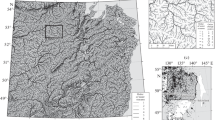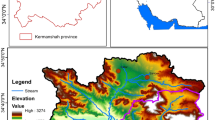Abstract
The proposed complex Parameter of River Network Self-similarity (PRNS), which is a combination of the exponents in the equations for distribution of channel lengths, the fractal dimension of channels, and the fractal dimension of points of change of the order of the channel, matches neotectonic movements more accurately. A comprehensive analysis of the self-similarity of the southern Sikhote-Alin River network model derived from the Digital Elevation Model (DEM) based on the Shuttle Radar Topography Mission image (SRTM) has been performed. Comparison of the results of morphostructural and fractal analyses showed the good consistency of these two methods. The relative PRNS maxima coincide with areas with the largest amplitude of ascending neotectonic movements (increment of relief), while the minima coincide with the areas either with the lowest increment of relief or with greatest erosion rates. Most of the crustal earthquakes are confined to the boundaries between PRNS relative maxima and minima, that is, uplifts are surrounded by seismic areas, which is due to the block nature of neotectonic vertical movements.











Similar content being viewed by others
REFERENCES
G. V. Bastrakov, “Erosion strength of rocks,” Geomorfologiya, No. 2, 52–55 (1977).
Vl. Voevodin, A. Antonov, D. Nikitenko, P. Shvets, S. Sobolev, I. Sidorov, K. Stefanov, Vad. Voevodin, and S. Zhumatiy, "Supercomputer Lomonosov-2: large scale, deep monitoring and fine analytics for the user community," Supercomputing Frontiers and Innovations, 6 (2), 4–11 (2019). https://doi.org/10.14529/jsfi190201
Geodynamics, Magmatism, and Metallogeny of East Russia, Ed. by A. I. Khanchuk (Dal’nauka, Vladivostok, 2006) [in Russian].
S. V. Gorkusha, F. S. Onukhov, and F. G. Korchagin, “Seismicity and neotectonics of the Russian Far East,” Tikhookean. Geol. 18 (5), 61–68 (1999).
A. N. Didenko, V. G. Bykov, N. V. Shestakov, V. A. Bormotov, M. D. Gerasimenko, A. G. Kolomiets, N. F. Vasilenko, A. S. Prytkov, and A. A. Sorokin, “March 11, 2011, Tokhoku Earthquakes. Data on network of deformation and seismological observations of Far East Branch of the Russian Academy of Sciences,” Vestn. DVO RAN, No. 3, 18–21 (2011).
A. N. Didenko, V. S. Zakharov, G. Z. Gil’manova, T. V. Merkulova, M. V. Arkhipov, “Formalized analysis of crustal seismicity in the Sikhote Alin orogen and adjacent areas,” Russ. J. Pac. Geol. 36 (2), 123–133 (2017).
V. S. Zakharov, “Analysis of the characteristics of self-similarity of seismicity and the active fault network of Eurasia,” Moscow Univ. Geol. Bull. 66 (6), 385–392 (2011).
V. S. Zakharov, D. A. Simonov, G. V. Bryantseva, and N. I. Kosevich, “Characteristics of self-similarity of water stream system of the Kerch Peninsula and their comparison with results of structural—geomorphological analysis,” Geofiz. Prots. Biosf., 18 (1), 50–60 (2019). https://doi.org/10.21455/GPB2019.1-5
Maps of the Youngest Tectonics of Northern Eurasia, Ed. by A. F. Grachev (AOOT VNIIZarubezhgeologiya, 1997). http://www.geokniga.org/maps/3465.
A. M. Korotkii, V. V. Korobov, and G. P. Skryl’nik, “Avalanches and landslides of the southern Russian Far East,” Geomorfologiya, No. 2, 50–59 (2009).
B. Mandel’brot, Fractal Geometry of Nature (Instl. Komp. Issled., Moscow-Izhevsk, 2002) [in Russian].
M. A. Mel’nik and A. V. Pozdnyakov, “Fractal analysis of erosionally rugged topography: methodological approaches,” Vestn. Tomsk. Gos. Univ. No. 301, 201–205 (2007) [in Russian].
M. A. Mel’nik and A. V. Pozdnyakov, “Fractals in the erosional rugging of surface and autofluctuations in the dynamics of geomorphosystems,” Geomorfologiya 3, 86–95 (2008). https://doi.org/10.15356/0435-4281-2008-3-86-95
I. I. Ngumanov, E. V. Ngumanova, and I. Yu. Chernova, Principles of Morphometric Method of Searching for Neotectonic Structures (Kazan. Univ., Kazan, 2016) [in Russian].
F. S. Onukhov and T. V. Merkulova, “Rotation of crustal blocks between strike-slip zones of the Lower Amur region based on morphostructural data,” Geomorfologiya, No. 4, 64–75 (2017).
A. Yu. Sidorchuk, “Fractal geometry of riverine networks,” Geomorfologiya, No. 1, 3–14 (2014). https://doi.org/10.15356/0435-4281-2014-1-3-14
D. A. Simonov and G. V. Bryantseva, “Morphostructural analysis in neotectonic reconstructions of the Kerch Peninsula,” Byull. Mosk. O-va Ispyt. Prir., Otd. Geol. 93 (3), 12–25 (2018).
D. A. Simonov, V. S. Zakharov, and G. V. Bryantseva, “Complex geomorphological, morphological, and fractal analysis of the most recent vertical tectonic movements of the Kerch Peninsula,” Moscow Univ. Geol. Bull. 74 (6), 549—558 (2019).
D. A. Simonov, V. S. Zakharov, G. Z. Gil’manova, and A. N. Didenko, “Neotectonic vertical movements in the South Sikhote-Alin and characteristics of self-similarity of drainage network in the region,” Moscow Univ. Geol. Bull. 75 (4), 330–341.
V. Yu. Timofeev, D. G. Ardyukov, P. Yu. Gornov, A. V. Timofeev, M. G. Valitov, and E. V. Boiko, “Modern movements of the continental margin of the Russian Far East based on the GPS observations,” Vestn. SGUGiT 22 (2), 88–102 (2017).
Feder, E., Fractals (Plenum, New York, 1988).
V. P. Filosofov, Principles of Morphometric Method of Searching for Tectonic Structures (Izd-vo Saratov. un-ta, Saratov, 1975) [in Russian].
S. A. Chupikova, Extended Abstract of Candidate’s Dissertation in Geography (Tomsk, 2010).
E. Dombradi, G. Timar, G. Bada, S. Cloetingh, and F. Horvath, “Fractal dimension estimations of drainage network in the Carpathian–Pannonian system,” Global Planet. Change 58, 197–213 (2007). https://doi.org/10.1016/j.gloplacha.2007.02.011
C. Donadio, F. Magdaleno, A. Mazzarella, and G. M. Kondolf, “Fractal dimension of the hydrographic pattern of three large rivers in the Mediterranean morphoclimatic system: geomorphologic interpretation of Russian (USA), Ebro (Spain) and Volturno (Italy) fluvial geometry,” Pure Appl. Geophys. 172, 1975–1984 (2014). https://doi.org/10.1007/s00024-014-0910-z
S. K. Jenson and J. O. Domingue, “Extracting topographic structure from digital elevation data for geographic information system analysis,” Photogrammetric Engineering and Remote Sensing 54 (11), 1593–1600 (1988).
M. G. Kogan, N. F. Vasilenko, D. I. Frolov, J. T. Freymueller, G. M. Steblov, A. S. Prytkov, and G. Ekstrom, “Rapid postseismic relaxation after the Great 2006−2007 Kuril earthquakes from GPS observations in 2007−2011,” J. Geophys. Res. 118 (7), 3691–3706 (2013).
J. D. Pelletier, “Self-organization and scaling relationships of evolving river networks,” J. Geophys. Res. 104 (B4), 7359–7375 (1999).
Search Earthquake Catalog: U.S. Geological Survey, 2019. Available from: https://earthquake.usgs.gov/ earthquakes/search.
A. N. Strahler, “Quantitative analysis of watershed geomorphology,” Trans. Am. Geophys. Union 38 (6), 913–920 (1957).
D. L. Turcotte, Fractals and Chaos in Geology and Geophysics, 2nd ed. (Cambridge Univ. Press, Cambridge, 1997).
USGS Earth resources observation and science (EROS) Center. www.usgs.gov/centers/eros. (accessed date of December 1, 2019).
V. S. Zakharov, A. N. Didenko, G. Z. Gil’manova, and T. V. Merkulova, “Characteristics of self-similarity of seismicity and the fault network of the Sikhote Alin orogenic belt and the adjacent areas,” Geodynam. & Tectonophys. 10 (2), 541–669 (2019). https://doi.org/10.5800/GT-2019-10-2-0425
ACKNOWLEDGMENTS
The authors are grateful to the reviewers A.V. Ivanov and V.I Usikova for their comments, which significantly improved the manuscript, and to E.Yu. Didenko for help with the processing the article.
Funding
This study was supported by the Russian Science Foundation (project no. 16-17-00015). The work was carried out using the equipment of the Multiple Access Research Computing Center of the Moscow State University [2].
Author information
Authors and Affiliations
Corresponding authors
Additional information
Recommended for publishing by A.I. Khanchuk
Rights and permissions
About this article
Cite this article
Zakharov, V.S., Simonov, D.A., Gilmanova, G.Z. et al. The Fractal Geometry of the River Network and Neotectonics of South Sikhote-Alin. Russ. J. of Pac. Geol. 14, 526–541 (2020). https://doi.org/10.1134/S181971402006007X
Received:
Revised:
Accepted:
Published:
Issue Date:
DOI: https://doi.org/10.1134/S181971402006007X




